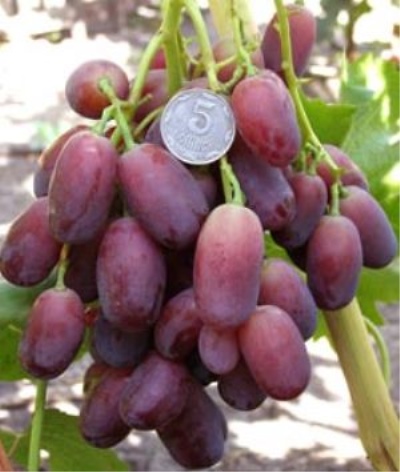
- Authors: Pavlovsky Evgeny Georgievich
- Appointment: dining room
- Berry color: Red
- Taste: harmonious
- Ripening period: early
- Ripening period, days: 110-115
- Bunch weight, g: 600-1500
- Flower type: bisexual
- Peeling: No
- Berry shape: oval
When growing grapes, it is recommended to choose a variety depending on how you plan to use the fruit. Different varieties have different uses, but among the dining rooms, the Jaguar is considered one of the best.
Breeding history
The variety under consideration was presented to the world by Evgeny Georgievich Pavlovsky.
Description
It is a table species with bisexual flowers on the vine. This variety belongs to vigorous ones. Therefore, the gardener should pay special attention to pruning. It is also worth mentioning that the Jaguar belongs to the hybrid forms.
Ripening period
In terms of ripening, the considered variety is early. It ripens in 110-115 days.
Bunches
The mass of bunches on bushes can vary from 600 to 1500 grams. With all this, there is no pea.
Berries
Ripe fruits turn red. The flesh is unusually crispy. The grapes have an oval shape, the weight of each fruit is from 12 to 16 grams.
Taste
Tasters rate the taste of the Jaguar as harmonious.
Yield
The considered type of grapes demonstrates high yield with high-quality care.


Growing features
If the grapes are planted on trellises, it is better to use metal posts that perfectly withstand the load during the ripening period.
Landing
The planting hole in which the plant is to be placed must be large enough to provide the necessary root space. If the season is dry, mulch can be spread around the vine.
Choose a warm and sunny location, either against a wall or fence. Vines will grow in most freely draining soils, provided they get plenty of sunlight. They can be grown successfully outdoors.
Roots need a lot of space and good drainage - cold won't affect growth, but moist roots will cause disease. Therefore, regardless of whether your grapes grow outdoors or indoors, the gardener should prepare the soil well, dig a large hole and add sand to the bottom, as well as a portion of rotted manure or garden compost.
If the grapes are grown outdoors, leave about 15 cm between the vine and the wall or fence and 1.5 m apart, with a row spacing of 1.5-2 m.

Pollination
During flowering, the stage begins when pollination occurs. The species in question is self-pollinated.Heavy rain or wind during this period can be a problem. In addition, low humidity, high air temperatures or drought can lead to a decrease in the quality of fertilization.
Pruning
The main task of pruning vines is to cut a limited number of new buds each year and completely remove the shoots from the previous season.

Watering
Drip irrigation is recommended for everyone involved in grapes so that water does not fall on the leaves, since excess moisture on them contributes to the development of fungal diseases.
If you have to water by hand, try to avoid spraying the foliage. Watering is carried out in the early morning so that excess moisture quickly evaporates in the sun.


Top dressing
If the soil is fertile, the gardener does not need to fertilize at all in the first year. Any fertilizer applied before planting, plus the natural quality of the soil, will suffice.
In the second and subsequent years, compost or matured manure is applied. You can also choose a light fertilizer like 10-10-10. It is used up to two times during the growing season. It is worth remembering that grapes usually do not like too much feeding.
Frost resistance and the need for shelter
The variety can withstand up to -20 ° С. After pruning, especially in cold regions, it is worth removing the vine from the trellis, laying it on the ground and covering it for the winter.

Diseases and pests
Gray mold can develop in humid conditions or where there is insufficient air movement around the plants. It infects buds, leaves, flowers and fruits and affects the overall growth and health of the plant and can be fatal to weak or damaged bushes.
When spots appear, the affected areas of the plant are removed and burned. As a preventive measure, fungicides, copper sulfate are used.

If a grape is exposed to any disease or insect, this always affects its appearance.
Storage
The berry can be kept in the refrigerator for about a week.











































































